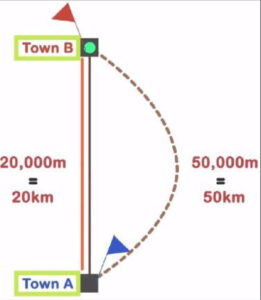Table of Contents
What is Displacement?
Displacement is the shortest distance moved between two places. Unlike distance, displacement is a vector quantity. This means it has a magnitude as well as a direction.
The SI unit of displacement is the same as that of distance that is metres (m).
What is the difference between distance and displacement?

Distance and displacement
In the figure, there are 2 paths mentioned for travelling from Town A to Town B.
When travelling on the curved path, the distance travelled is 50,000 m. When travelling on the straight path, the distance covered is 20,000 m.
But the shortest distance between the 2 towns is only on one path, that is the straight path of 20,000 m. Hence, the displacement from Town A to Town B is 20,000 m.
Solved examples on Displacement Formula
Example 1: A car travels from point A to point B along a straight road. The car initially starts at point A and moves 200 meters to the east, then changes direction and moves 150 meters to the north to reach point B. Calculate the displacement of the car from point A to point B.
Solution:
To calculate the displacement, we need to find the straight-line distance and direction between the initial and final positions.
Using the Pythagorean theorem, we can find the straight-line distance traveled by the car:
Distance = √((200 m)² + (150 m)²)
Distance = √(40000 m² + 22500 m²)
Distance ≈ √62500 m²
Distance ≈ 250 m
The direction of the displacement can be determined by finding the angle between the initial and final positions. Using trigonometry, we can calculate the angle:
tan θ = opposite/adjacent = (150 m)/(200 m)
θ ≈ 36.87°
Therefore, the displacement of the car from point A to point B is approximately 250 meters in a direction of 36.87° north of east.
Example 2: A hiker goes on a hiking trip and follows a trail with several turns. The hiker walks 100 meters to the east, then turns and walks 50 meters to the south, and finally turns again and walks 70 meters to the west. Calculate the displacement of the hiker from the starting point.
Solution:
To find the displacement, we need to determine the net displacement from the starting point, considering both the magnitudes and directions of the individual displacements.
First, let’s break down the given displacements into their respective components:
Horizontal displacement: 100 meters east – 70 meters west = 30 meters east
Vertical displacement: 50 meters south
Now, we can calculate the resultant displacement using these components:
Resultant displacement = √((Horizontal displacement)² + (Vertical displacement)²)
Resultant displacement = √((30 m)² + (50 m)²)
Resultant displacement = √(900 m² + 2500 m²)
Resultant displacement = √3400 m²
Resultant displacement ≈ 58.31 m
The direction of the displacement can be found by calculating the angle:
tan θ = opposite/adjacent = (50 m)/(30 m)
θ ≈ 59.04°
Therefore, the displacement of the hiker from the starting point is approximately 58.31 meters in a direction of 59.04° south of east.
Frequently Asked Questions on Displacement Formula
What is displacement?
Displacement refers to the change in position of an object, measured in terms of both magnitude and direction. It represents the straight-line distance between the initial and final positions of the object.
How is displacement different from distance?
Distance is a scalar quantity that represents the total path length traveled by an object, regardless of direction. Displacement, on the other hand, is a vector quantity that considers only the change in position and accounts for direction.
How is displacement calculated?
Displacement can be calculated by finding the difference between the final and initial positions of an object. This can be done by subtracting the initial position vector from the final position vector. The magnitude of the displacement can be determined using the Pythagorean Theorem, and the direction can be found using trigonometric functions.
Can displacement be negative?
Yes, displacement can be negative. Negative displacement occurs when an object moves in the opposite direction to the reference point or initial position. It indicates that the object has moved in the opposite direction of a positive displacement.
Can displacement be zero?
Yes, displacement can be zero. A zero displacement means that the object has not moved or has returned to its initial position. It indicates that the final position is the same as the initial position.
What is the difference between displacement and position?
Position refers to the location of an object at a particular instant in time. It is described using a coordinate system, such as x, y, and z coordinates. Displacement, on the other hand, represents the change in position from the initial position to the final position of an object.
How does displacement relate to velocity?
Displacement is related to velocity, as velocity is defined as the rate of change of displacement with respect to time. In other words, velocity describes how an object's position changes over time.







